Featured image credit: Los Angeles Times
Sure, parts of Hollywood Boulevard resemble a warzone. But it’s hard to imagine real war ever touching LA’s palm-peppered shores. So, it may surprise you to read that the Greater Los Angeles area was the setting for one of World War II’s smallest battles. Or sort-of-battles. It only lasted about an hour. And the invaders (if any) remain a mystery to this day. Yet, just after 2am on Wednesday, February 25, 1942, the city erupted into what has gone on to be called the Battle of Los Angeles.
Palpable Tensions Leading Up to the Battle of Los Angeles
In the weeks following the infamous attack on Pearl Harbor, it was a lot easier to imagine war falling on Los Angeles than it is today. In fact, much of the U.S. seemed ripe for attack… and the tension occasionally boiled over into real life consequences. For example, rumors of incoming aircraft sent New York City into a full blown panic, knocking stock prices off their precarious perches on December 9, 1941.
A “better safe than sorry” approach was rapidly becoming the norm, leading to frequent occurrences of mistaken identity. Everything from commercial fishing boats to drifting logs inspired reports of incoming Japanese forces. Even a pod of whales could be (and was) easily mistaken for a hostile submarine fleet by a rookie radar officer.
When Secretary of War (yes, that was a thing) Henry Stimson cautioned Americans to expect “occasional blows” from the enemy, it had all of the calming effects of a head-on collision. And perhaps no U.S. city was more jumpy than Los Angeles.
Why Los Angeles Seemed Primed for Attack
At the time, Los Angeles was a massive force in the U.S.’s military manufacturing efforts. By 1941, LA ranked number one among American cities in aircraft production. The city also excelled at ship manufacturing.
San Pedro Bay already harbored a massive armada of naval vessels. By October, shipbuilders had ramped up production with a dramatically increased workforce: up from 1,000 in 1939 to approximately 22,000 workers. With LA so integral to the U.S. war effort, its precarious position on the Pacific Ocean made it a prime target for attacks from the Japanese army.
Sub Mission in LA
But it was too risky for Japanese forces to bring their aircraft carriers anywhere near the U.S. coastline. Instead, they preferred the stealth approach of submarines. And, unsettlingly, they had modest success in their offensive maneuvers in California waters.
On December 23, 1941, Japanese submarines torpedoed the Montebello oil tanker, sinking it somewhere off the California coast. The next day, submarines also attacked a lumber ship, the SS Absaroka, killing a member of its crew.
Submarine attacks carried on into the next year. On February 23, 1942, a Japanese submarine surfaced off the coast of Santa Barbara, lobbing artillery at an oil refinery. Though the attack was largely unsuccessful, it was still soberingly significant. It was the first time that the mainland United States had been bombed by enemy forces during the second World War.
February 25, 1942: The Battle of Los Angeles
Los Angeles was reasonably poised for a major attack from Japanese forces. And tensions couldn’t have climbed much higher than they did on February 24, 1942, just a day after the bombing of the Santa Barbara oil fields. Naval intelligence officially cautioned military stations along the California coast to prepare for the likelihood of a Japanese attack. And thus were the conditions created for the Battle of Los Angeles.
It was just after 2am on that fateful night of February 25 when a radar officer detected something in the skies about 120 miles off the coast of LA. All thoughts turned to enemy aircraft. Over the next 15 minutes, an additional two stations confirmed the flying object. Fearing an attack was imminent, the military instituted a citywide blackout and fired up the air raid sirens.
Searchlights scraped the ominous black firmament as manned anti-aircraft turrets scoured the skies for any sign of the enemy. The tension remained impossibly unbreakable as a city collectively sweated in dread.
Then, on the shoreline of Santa Monica, just a little after 3am, the first shots rang out, punctuating the wail of the sirens. A chorus of .50 caliber machine guns joined in quickly followed by military-grade fire all the way along the Los Angeles coast. The Battle of Los Angeles had begun.
Fighting an Unseen Enemy
At this point, eyewitness accounts begin to diverge. However, most will agree that, despite watching the skies with unblinking eyes, there was no sign of the enemy, Japanese or otherwise. Civilians climbed through the darkness to their rooftops to apprehensively watch the war that had finally come to California. Smoke snaked upward through the night, briefly illuminated by the blasts of gunfire aimed upward into the spotlight-stained void. A nearly 40-mile coastline of artillery fire punctuated the night over the course of the next hour. From Santa Monica to Long Beach, Los Angeles watched as the military fiercely battled unseen forces.
The sun slowly rose, illuminating a sky that had been torn through with over 1,400 rounds of anti-aircraft ammunition. But with the dawn came a strange realization. No damage could be attributed to enemy forces. The brutalized facades of buildings and obliterated windows were all linked to friendly fire. Some homes had even been rendered uninhabitable by falling artillery. Shockingly, not a single life was claimed by the gunfire.
Sadly, the same couldn’t be said for the blackout. Between the disorientation and the sensory overload of the sirens in the darkness, at least five people lost their lives in the wee hours of February 25. The causes of death ranged from automobile accidents to heart attacks. Yet, not a single enemy bullet had fallen on Los Angeles soil. The Battle of Los Angeles was increasingly beginning to look one-sided.
Post-Battle Shame
The government, the media, and the people weren’t exactly seeing eye to eye on the events of February 25. Secretary of the Navy Frank Knox simply wrote the incident off as “jittery nerves.” And, for better or worse, this seems to be the most plausible account of what unfolded in LA’s skies that night. Between the roving searchlights and barrage of anti-aircraft fire, it wouldn’t be too difficult to mistake tricks of light for swooping enemy fighter planes.
The Battle of Los Angeles also trailed a more disturbing effect of World War II on American soil. Days earlier, President Franklin D. Roosevelt had issued executive order 9066. This controversial order authorized a distinct stain on America’s history: the internment of Japanese-Americans.
Executive order 9066 aimed to address fears of Japanese-Americans collaborating with the Japanese military to attack the U.S. from within. During the Battle of Los Angeles, the inherent racism of executive order 9066 became abundantly clear. Though it appeared there had never been a single Japanese plane in the sky over LA that night, authorities still managed to arrest over 20 Japanese-Americans in the blackout. Their alleged crime? Signaling Japanese aircraft.
Giving Form to the Formless
Secretary of War Stimson chimed in after the Battle of Los Angeles to echo the official statement of the US military. According to the military, at least 15 planes had descended upon the city that night. Stimson even lent further credence to the rumor that the enemy had used commercial planes instead of fighter planes to execute the invasion.
Stimson later distanced himself from these claims. Yet, the fact remained that thousands of Angelenos and military personnel alike claimed to have seen something in the skies that night. Over the decades, Japan has emphatically denied flying any aircraft over Los Angeles at any point during World War II.
So, was the Battle of Los Angeles a monumental case of mass delusion? Or was there something soaring over the city on February 25? A New York Times article published about the incident reported eyewitnesses claiming to have spotted “a big floating object resembling a balloon.” Others stuck by their stories of actually seeing enemy aircraft.
It wasn’t until 1983 that the Office of Air Force History weighed in with an official take on the events of February 25, 1942. They pinned the confusion on a series of silver weather balloons that were being utilized to measure wind conditions. These weather balloons were outfitted with lights that may have also contributed to the turmoil. But the weather balloon explanation gives way to a more otherworldly theory.
Invaders or Space Invaders?
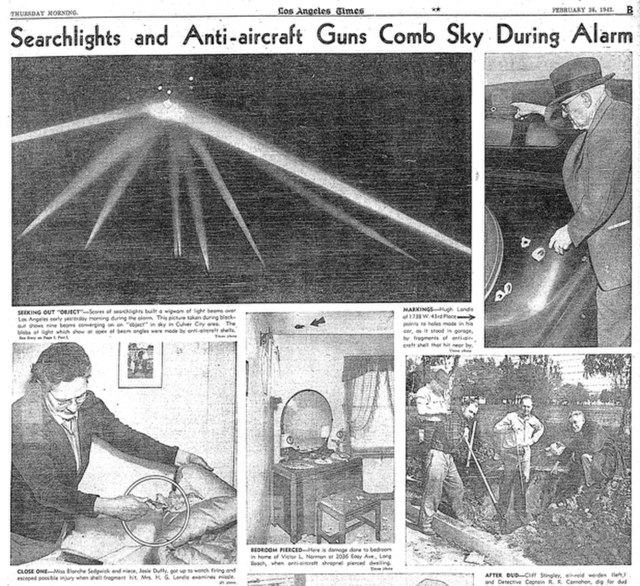
A small but vocal group believes that the invaders that allegedly flew into LA airspace on February 25 were of the space variety. As is so often the case when strange lights appear in the sky, the Battle of Los Angeles has attracted plenty of attention from UFO conspiracy theorists. Many believers of extraterrestrial visitation think that the US military went to battle with alien aircraft that fateful night. Some have even interpreted a photograph published in the February 26, 1942 edition of the Los Angeles Times as proof of this claim. In the photo, military searchlights appear to be trained on… something.
Was it just a trick of light from the nexus point of the searchlights? The gleam of the beam on flying bullets? A weather balloon drifting into an unfortunate path? Or was it a visiting vessel from another world? Skeptics have put forth that the photo was likely edited per standard practice for newspapers at that time. But it’s not enough to dissuade the UFO faithful.
The Sobering Truth of the Battle of Los Angeles
So who visited Los Angeles in the wee hours of February 25, 1942? Was it enemy fighter planes? Weather balloons? Space invaders? Or just fear itself? No matter what, if anything, descended from the darkness into LA’s airspace, the Battle of Los Angeles is a stark reminder to remove our rose-tinted glasses when viewing the past. The “simpler times” weren’t often that simple at all. And if you don’t agree, our skies were torn apart by 1,400 rounds that would say otherwise.
With a brand that says as much as JohnHart’s, Senior Copywriter Seth Styles never finds himself at a loss for words. Responsible for maintaining the voice of the company, he spends each day drafting marketing materials, blogs, bios, and agent resources that speak from the company’s collective mind and Hart… errr, heart.
Having spent over a decade in creative roles across a variety of industries, Seth brings with him vast experience in SEO practices, digital marketing, and all manner of professional writing with particular strength in blogging, content creation, and brand building. Gratitude, passion, and sincerity remain core tenets of his unwavering work ethic. The landscape of the industry changes daily, paralleling JohnHart’s efforts to {re}define real estate, but Seth works to maintain the company’s consistent message while offering both agents and clients a new echelon of service.
When not preserving the JohnHart essence in stirring copy, Seth puts his efforts into writing and illustrating an ongoing series entitled The Death of Romance. In addition, he adores spending quality time with his girlfriend and Romeo (his long-haired chihuahua mix), watching ‘70s and ‘80s horror movies, and reading (with a particular penchant for Victorian horror novels and authors Yukio Mishima and Bret Easton Ellis). He also occasionally records music as the vocalist and songwriter for his glam rock band, Peppermint Pumpkin.


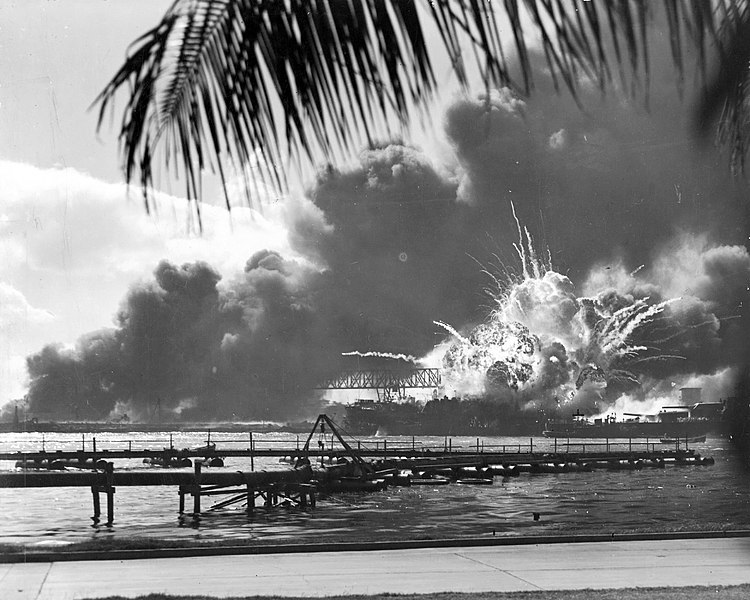
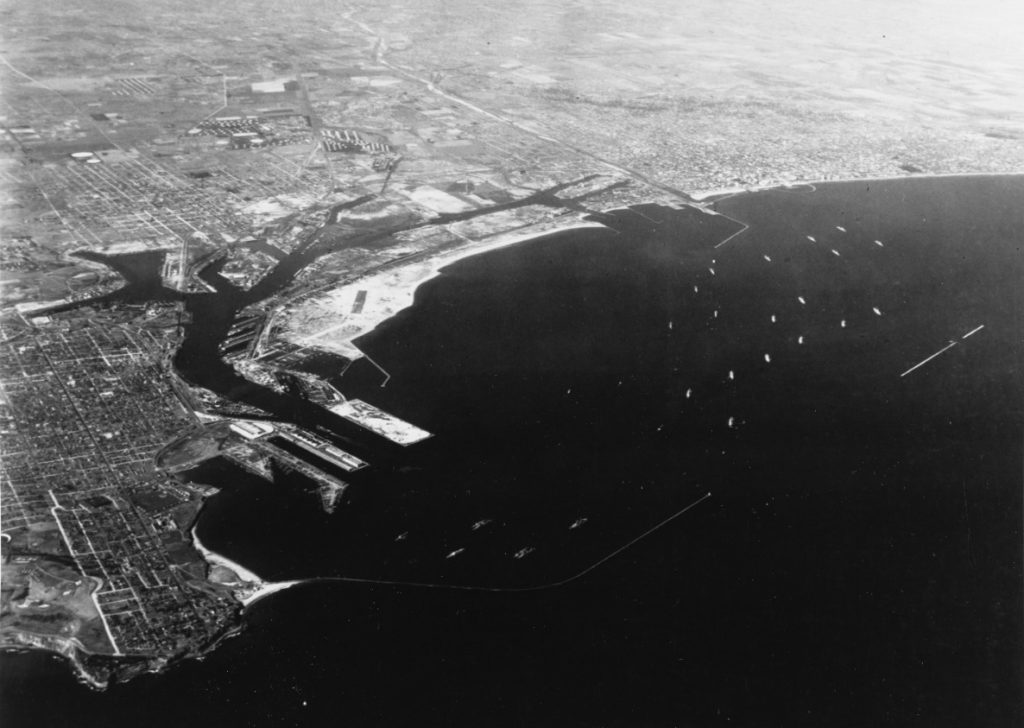
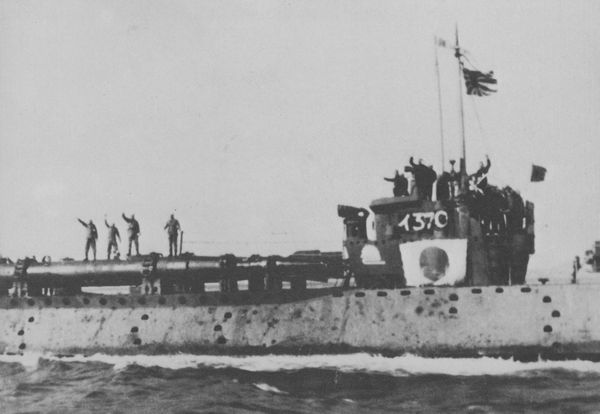
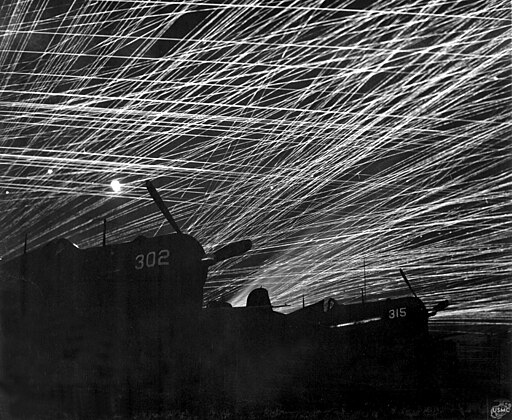
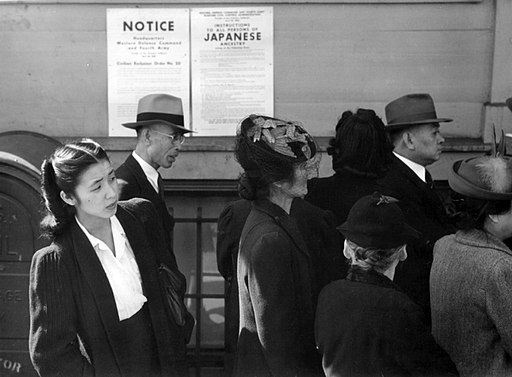
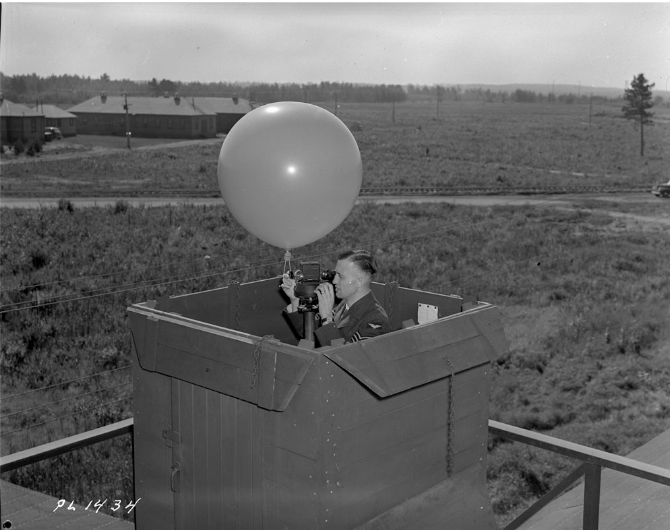

Seth – one historical error in the Battle of Los Angeles article. The US president was not Theodore Roosevelt. The US President during WWII was Franklin D. Roosevelt – a relative of President Theodore Roosevelt. Otherwise, you wrote a very interesting article. Thank you.
What an embarrassing oversight! Thanks for catching it – correcting now.
Seth, three times you mentioned Japanese fighter jets. Allow me to point out that in 1941, there were no fighter jets. They were being developed by both Germany and Britain, but the German Me 262 and the British Gloster Meteor did not go into service until the middle of 1944. The Japanese had only one prototype, the Nakajima Kikka, and it flew only once in August of 1945. Your editor dropped the ball on this one. Research… An important tool in developing a successful career in journalism.
Writer and editor here… and a bunch of other things in between; jack of all, master of some. Not much of a war buff though, so thanks for clarifying this important distinction! Any thoughts on what was happening up in the sky that night?